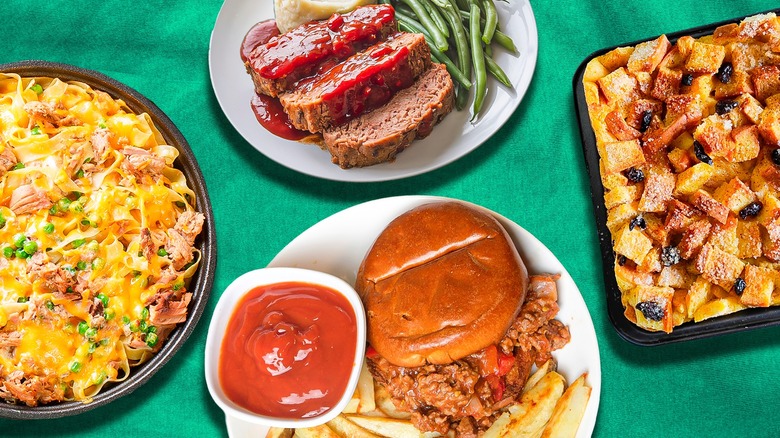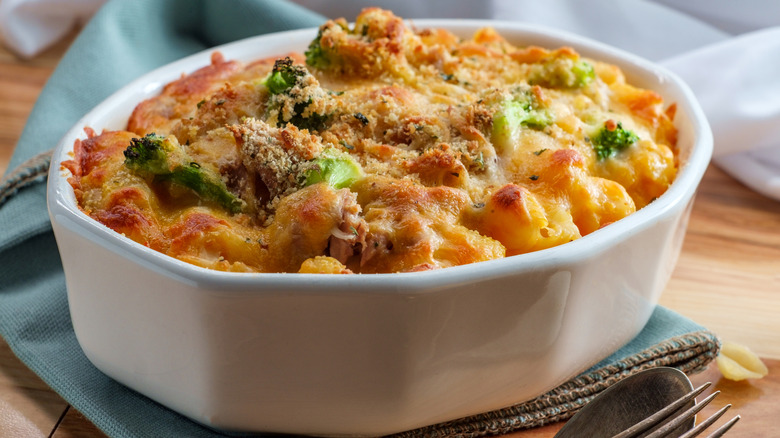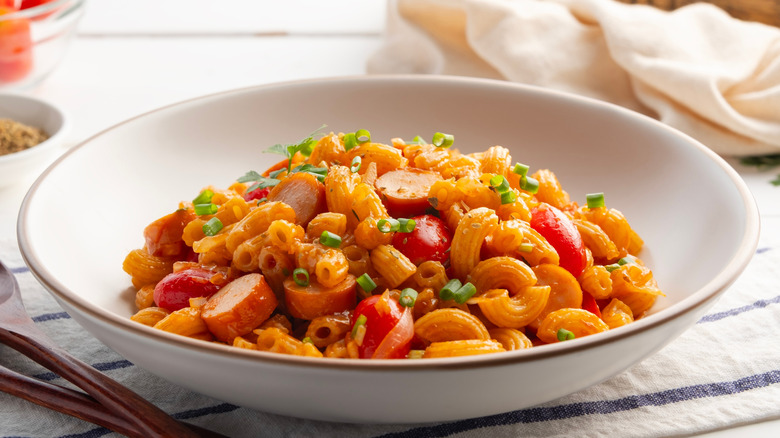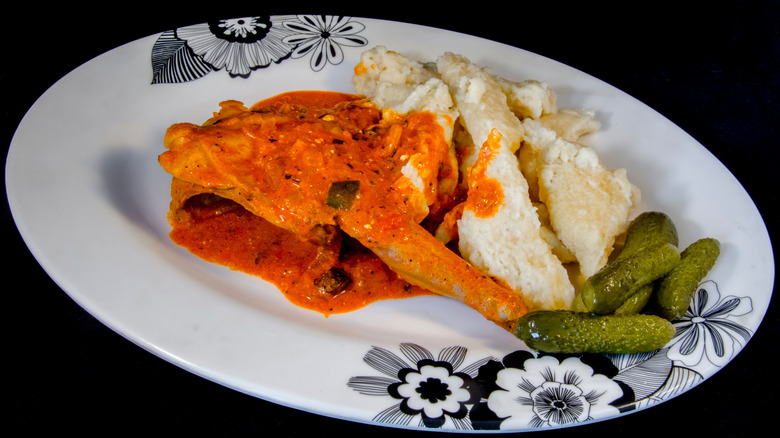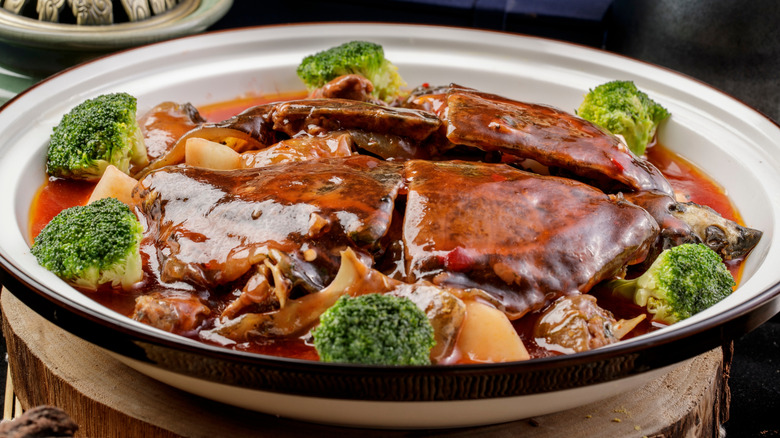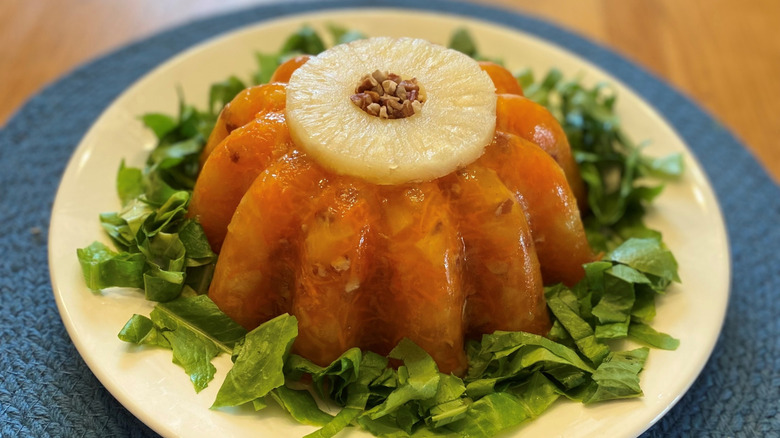11 Old School Comfort Foods You Rarely Find At Dinner Tables Today
When you're having the worst possible day, there are few things that can help more than a warm plate of your favorite comfort food. A meal that maybe offers more emotional support than its nutritional benefits, comfort foods are steeped in nostalgia. Memories of a better time, when things were simpler (or at the very least, when you were younger). Specifically, a lot of old school comfort foods have origins in mid-century America, a time of imagined ideals as the country was on the tail of the Great Depression and World War II.
Most of these meals listed below also have origins in working class people struggling to make the most out of their meals — which means comfort foods are often very fatty, salty, or sweet. These meals grew less popular as economic and social realities shifted, where one member of the household (often women) were no longer burdened with the exclusive obligation of cooking, and that labor was outsourced to prepackaged food production, fast food restaurants, and other external sources for food. As current economic troubles affect millions of Americans, we may see a resurgence of these low-cost meals.
1. Tuna casserole
Perhaps one of the most iconic meals in all of American history, the casserole stands as the pinnacle of mid-century culture. Popularized in the late 1940s and made mainstream in the 1950s, the casserole became an affordable social symbol for women across North America, who had their social power and creative expression relegated to domestic realms in a patriarchal society after serving as the backbone of industry during World War II. Having a family dinner? Make a casserole. Welcoming a new family to the neighborhood? Bring over a casserole. Want to impress your friends at a work social? You already know what we're going to say.
While the first tuna casserole recipe was allegedly published in a magazine in 1930, the casserole dish is highly flexible and easy to make, with small changes in ingredients creating vastly different meals. The culinary trend picked up steam with recipes in magazines such as Good Housekeeping and Ladies' Home Journal, before going fully mainstream in cookbooks by Betty Crocker (yes, she's a fictional person) and James Beard. While casseroles may have fallen out of fashion, the dish's legacy lives on.
2. Meatloaf
As long as there has been meat, there have been people grinding it up and making it into a vague loaf-like shape (along with other, less solid forms). Similar to a casserole in its one-pot, throw-everything-together-and-bake-it nature, a good meatloaf is cheap, easy to make, and brimming with possibilities. It's easy to see why this simple and cheap use of ground meat is so popular — and why versions of it became so popular in Depression-era America.
According to authors Frank Bruni and Jennifer Steinhauer's comprehensive history of the dish, "A Meatloaf in Every Oven," the dish as we know it appeared not as a lunch or a dinner meal — but rather a breakfast food. An early recipe for the American staple was penned in the "Boston Cooking-School Cook Book," featuring veal with breadcrumbs and eggs, though other iterations combined ham, nutmeg, cayenne, crackers, and even lemon rind. Meatloaf became popularized during the Great Depression, when impoverished Americans could make more with less by cutting the meat with such as Milkorno.
3. Sloppy Joes
Chili and its sandwich iteration, sloppy Joes, are meatloaf's less pretty cousin. Made from ground meat, the sloppiest of Joes are stretched with tomatoes, onions, and flavored with Worcestershire sauce, Dijon mustard and brown sugar. The history of sloppy Joes is highly contentious, with claims to the one true Joe hailing from a Gulf Coast blend of Havana and Key West, or strangely enough, an hour outside of Sioux City, Iowa. According to the bar's history, the former story starts with José Garcia, a Spanish immigrant to Cuba who — after spending some time working in bars in New Orleans and Miami — opened a bar in Havana so messy his patrons dubbed him Sloppy Joe. His signature sandwich mixed the Cuban dishes ropa vieja and picadillo. One of Garcia's regulars famous author Ernest Hemingway allegedly brought his love of sloppy Joes creation to his friend Joe Russell's bar in Key West.
The second story of the sandwich is said to originate from loose meat sandwiches in the midwest during the 1920s. The Iowans who lay claim to the sandwich fall on opposite sides of the state: on the west, Dave Higgins in 1924 at Ye Olde Tavern Inn in Sioux City, and to the east Maid Rite opened in Muscatine, Iowa, two years later. Regardless, all origin stories were eclipsed by the capitalistic behemoth that was to be Manwich, the canned, ready-to-go version that made sloppy Joes a household name.
4. Hoover stew
American comfort foods often originated during the Great Depression, a time of economic turmoil brought on by the actions of wealthy stock market investors crashing the market and President Herbert Hoover's isolationist, America First policies (such as tariffs) — and affected Americans made sure to name the tangible negative impacts of those policies after him.
One such downstream effect was the creation of Hoover stew, a meal made by popular Italian-Americans consisting of canned goods, pasta, and processed meat. Akin to macaroni and hot dogs, this meal embodied the scrappy nature of Americans suffering under the difficult conditions placed on them by a wealthy ruling class. However, Hoover stew hasn't fully fallen out of fashion, there are plenty of ways to upgrade the tasty Depression-era dinner dish. According to Bruce Kraig and Patty Carroll's "Man Bites Dog: Hot Dog Culture in America," enterprising restaurateurs Don and Rasheedah Scott opened up Otis Jackson's Soul Dog in North Hollywood, California, where they blend soul food — the pinnacle of American comfort food made and perfected by Black Americans — with hot dogs.
5. Chitterlings
The Southern soul food delicacy of chitterlings (otherwise known as chitlins) has a long and troubled history. Made from hog intestines, pieces of the animal that are often discarded, chitterlings involve an intensive the process to prepare them — often taking roughly two to three hours to successfully clean them.
While holding an essential place in American cuisine, chitterlings are derived from the traditions of enslaved people and their descendants. While working in the fields and in the kitchen, enslaved people brought culinary traditions from their home countries and blended them with the traditions, ingredients, and tools available to them. After the end of slavery, sharecroppers and free Black communities who were oppressed in the Jim Crow South made-do with the limited resources they had at hand. Today, chitterlings are a known delicacy food that Guy Fieri strongly disliked after he tasted the dish on a Season 17 episode of "Diners, Drive-Ins, and Dives."
6. Bread pudding
This deeply American meal bread pudding actually finds its origins in Great Britain. Consisting entirely of a stale piece of bread, methods of preparation could not be simpler. After being soaked in milk, the pudding is then baked and served. Really, that's it. According to Jeri Quinzio in her book, "Pudding: A Global History," a recipe for bread pudding can be found dating all the way back to the 1800s. Isabella Beeton's recipe called for the bread to be soaked in water, though she does admit that milk would "very much improve" the final product.
Beeton's contemporary Eliza Acton alluded to the economic means of the individuals making such a food by calling her recipe "The Poor Author's Pudding" — while cheekily alluding to a more complicated version "The Publisher's Pudding," even going so far as to make a cultural commentary through her writing saying that the dish could "scarcely be made too rich." The East Asian interpretation of this meal, often made by many immigrants to America, is called congee. It uses rice instead of bread. In addition to sweet, it can be made savory with various ingredients such as soy sauce, pickled vegetables, and eggs.
7. Rabbit dumplings
One of the major environmental crises that coincided with the Great Depression was The Dust Bowl, leaving vast swaths of American agricultural land untenable for growing food, resulting in many Americans having to hunt for their food. One such animal that was available in abundance was rabbits, specifically jackrabbits. In Kansas specifically, there were reportedly 8 million of them in just 30 counties.
Rabbit stew was a meal that was easy enough to make and offered plenty of nutrients.The dumplings were similarly easy to make, as the flour needed to make them was one of the few inexpensive and widely available ingredients. Granted, while rabbit stew is a delicacy across the world, the creatures have become an iconic symbol of innocence in American culture from the Easter Bunny to the iconic line in The Dust Bowl-era novel and film "Of Mice and Men," so you might have a bit of a difficult time finding this meal on your dinner table any time soon.
8. Creamed chipped beef and toast
This classic meal also comes from the Depression era. A salty dried beef snack, covered with gravy and on golden brown toast is about as comforting as you can get. While the meal dates back to 18th century British sailors, it's rumored to have entered the American zeitgeist during the brutal westward expansion of American colonialists. Even more significantly, it became a breakfast or dinner staple for the United States military after it was first published in the official Army cookbook in 1910.
Endearingly called S**t on a Shingle, creamed chipped beef on toast was easy to make a lot of very quickly, and stayed a military staple through the Vietnam War. As soldiers from these wars left the service and moved into civilian life, it's understandable how this meal would provide a sense of comfort and familiarity. Allegedly, the meal has since been phased out of use as the U.S. military has updated its rules on nutrition.
9. Dandelion salad
Foraging is having a bit of a moment on social media in the last few years. Influencers like the James Beard Award-winning Alexis Nikole Nelson have brought the traditional food gathering method back into the mainstream, and one American favorite is the dandelion salad. In a 1916 publication "Dandelions as Food," Cornell University's College of Agriculture detailed the nutritional benefits of the flower, when to harvest them, and how to prepare them for consumption (with recipes including dandelion soup, timbales, and more).
A more recent study from February 2025 with the "International Food Research Journal" indicated that dandelions, while being a bit bitter in taste, have been used in traditional Chinese medicine — and for good reason. Dandelions have large amounts of nutrients including iron, calcium, sodium, magnesium, and vitamins A, B, C, E, and K. While it may be a bit more difficult to forage non-pesticide covered dandelions for consumption today, knowing local edible and medicinal plants is always a good skill to have.
10. Turtle soup
Much like rabbit dumplings, turtle soup is a dish that some people might feel is a little bit off-putting. But turtle soup has traveled across the world, reaching the height of luxury and the pit of poverty. According to May-bo Ching's "The Flow of Turtle Soup from the Caribbean via Europe to Canton, and Its Modern American Fate," English sailors colonizing the West Indies (and the people they enslaved) ate turtle soup in abundance, specifically prepared with a sherry wine sauce.
In the 18th century, Hannah Glass (a recurring figure in early culinary writing) wrote about "Dressing a turtle the West India Way," to describe how this delicacy was prepared. So how did it become an American comfort food? The former-British colonies brought this delicacy over. From the late 1800s, everyone ate turtle soup, from aristocratic "turtle frolics" to enslaved people catching turtles in the south. While individuals catching turtles to survive had less of an impact on the North American turtle population, over-harvesting of turtles at this level led to a near-extinction of the species ... until the Prohibition in the 1920s saved them. Maria Cathell, executive director of the Museum of Chincoteague, told NPR: "Sherry was a key ingredient in terrapin soup [and] without access to sherry, the popularity of the soup plummeted." While the catching of turtles for impoverished folks in the southeastern U.S. still occurred, the species was able to significantly recover, though the meal never quite reached the same popularity.
11. Jell-O salad
While the Jell-O brand feels like an American institution, gelatin and its related cuisine actually dates back to medieval Europe. Up until the 1800s, it was viewed as a food for the aristocracy due to its immensely long preparation process, with one British author Hannah Glasse describing the extensive process back in 1747. Colonial American aristocrats brought the tradition over, with rich folks from New York to Georgia enlisting their staff (or enslaved people) to make it for them. The food only became a staple for working class people after the Industrial Revolution. After the publication of Upton Sinclair's "The Jungle," people became significantly more concerned about food safety, and Jell-O marketing at the turn of the 20th century marketed it as "safe" and "pure."
The thing that truly congealed Jell-O into American culture is Mrs. John Cooke's third place victory in a Knox Gelatin-sponsored cooking contest, where she made "Perfection Salad" which contained chopped cabbage, celery, and red pepper. From there, marketing for Jell-O salads exploded with advertisements in the same magazines that popularized casserole, dipping only slightly when sugar was rationed during WWII, before coming into full swing in the post-war era. While this dish has fallen out of fashion, fruity Jell-O salads remain popular in more rural parts of the country, with savory salads keeping their staying power in Utah — with Jell-O being named as the state's official state snack in 2001.
